一 概念
synchronized (Object)
– 不能用String常量 Integer Long
– “object”
二 CAS (无锁优化 自旋)
1.0 场景使用 T01_AtomicInteger atomic类型的都是CAS实现的框架
import java.util.concurrent.atomic.AtomicInteger;
public class T01_AtomicInteger {
/*volatile*/ //int count1 = 0;
AtomicInteger count = new AtomicInteger(0);
/*synchronized*/ void m() {
for (int i = 0; i < 10000; i++)
//if count1.get() < 1000
count.incrementAndGet(); //count1++
}
public static void main(String[] args) {
T01_AtomicInteger t = new T01_AtomicInteger();
List<Thread> threads = new ArrayList<Thread>();
for (int i = 0; i < 10; i++) {
threads.add(new Thread(t::m, "thread-" + i));
}
threads.forEach((o) -> o.start());
threads.forEach((o) -> {
try {
o.join();
} catch (InterruptedException e) {
e.printStackTrace();
}
});
System.out.println(t.count);
}
}
1.1 多个线程同时修改缓存中的一个值,不使用锁且能准确修改不出现并发多线程间的串改?
使用 CAS
读取当前值 计算结果 比较当前新的值与原来我读出来来的值是否相等,如果一样说明没人变过,我就把你变为新值;如果有人变过再重新读取新的值在进行计算比较,直到这个值和读出来的值一样后进行修改了为止;
1.2 ABA 问题
如果是基础类型的话无所谓,但是如果是引用类型的话就不行
添加verison 来解决
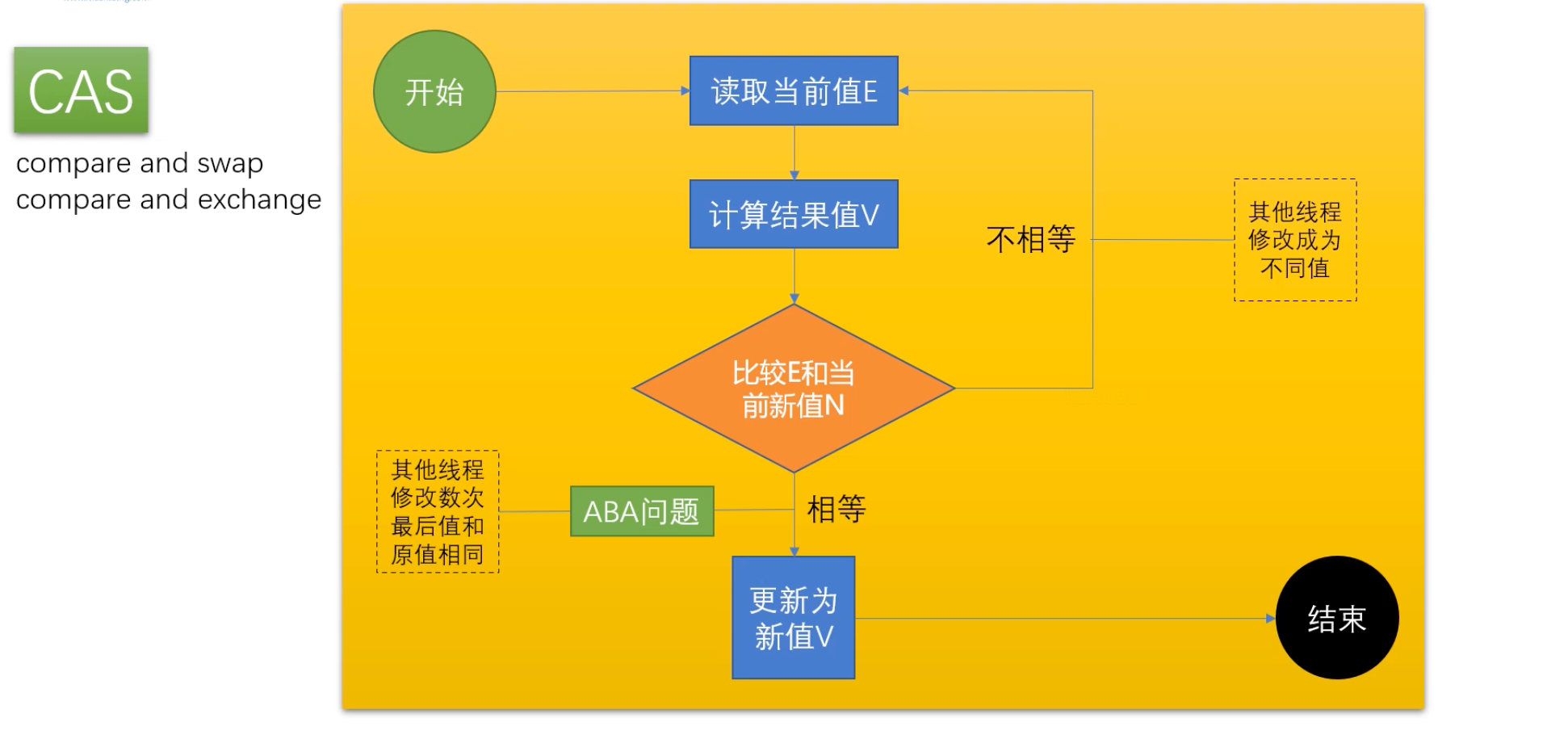
1.3 CAS 的底层是如何实现的?
Lock cmpxchg 指令
为什么CAS底层要通过lock来实现?因为我们要保证在和旧值比较和往回写改的过程要保证是原子性,不然还是会被别人打断;
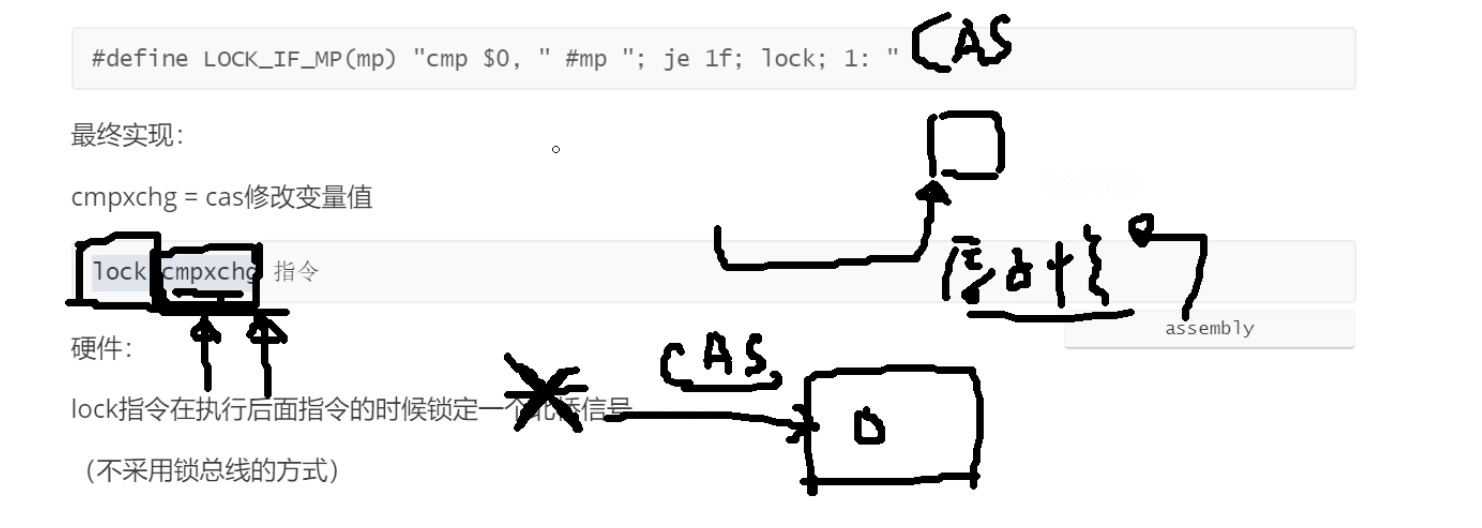
1.4 用户态和内核态
操作系统能做的事情绝对不能让用户去做,为了操作系统的健状性,将内存的执行过程分为了内核态(能访问所以的指令)和用户态(只能访问用户允许的指令);
1.5 synchronized在jdk 早期为什么说是重量级锁?
因为synchronized在向某个线程加锁的时候都需要先向操作系统申请锁,申请成功后从内核再到用户态;
1.6 对象的内存布局?
markword 8个字节
class pointer 类型指针 4个字节 通过这个可以找到这个对象属于那个类的 .class
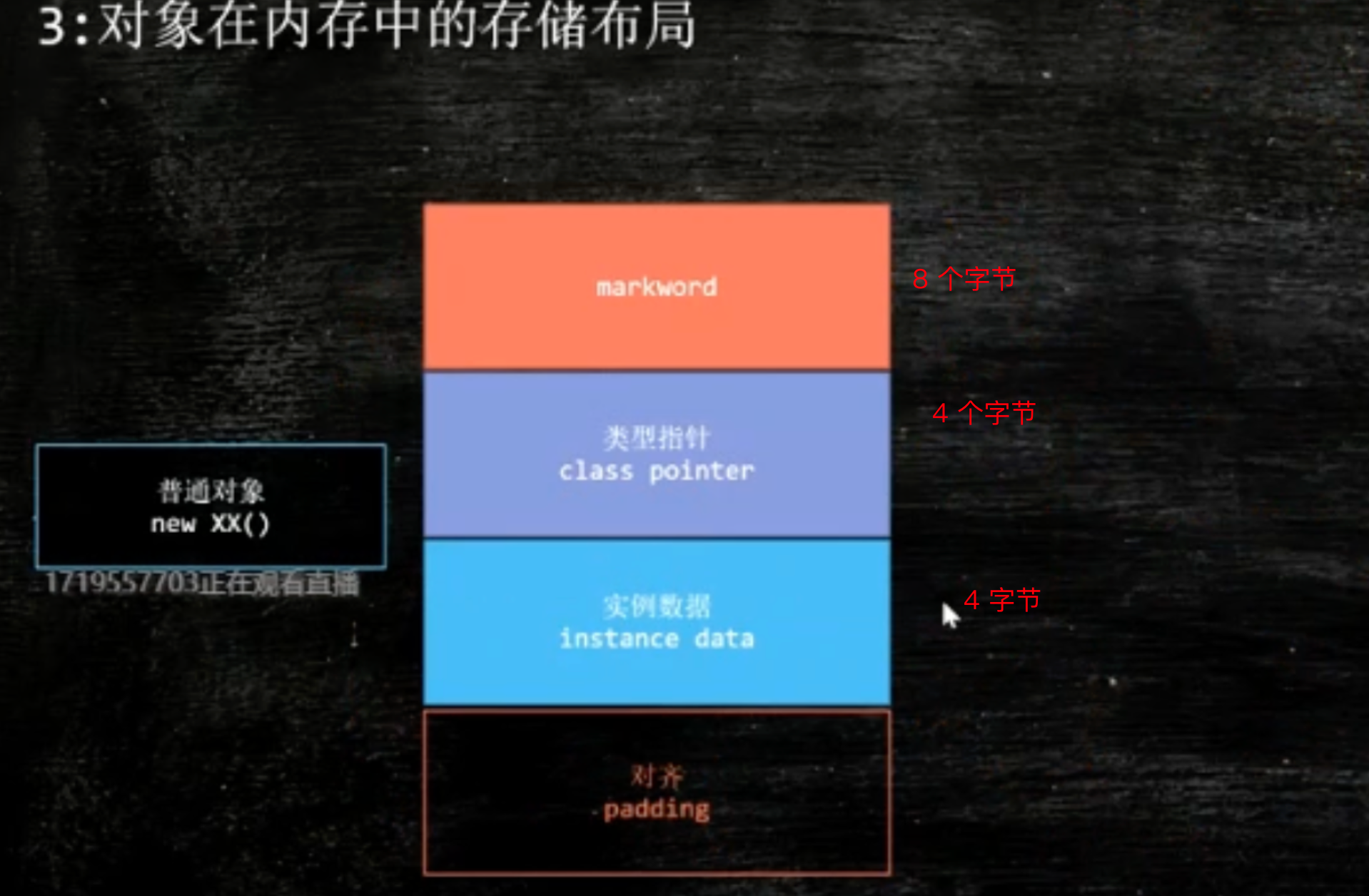

1.7 锁 偏向锁 自旋锁 重量级锁
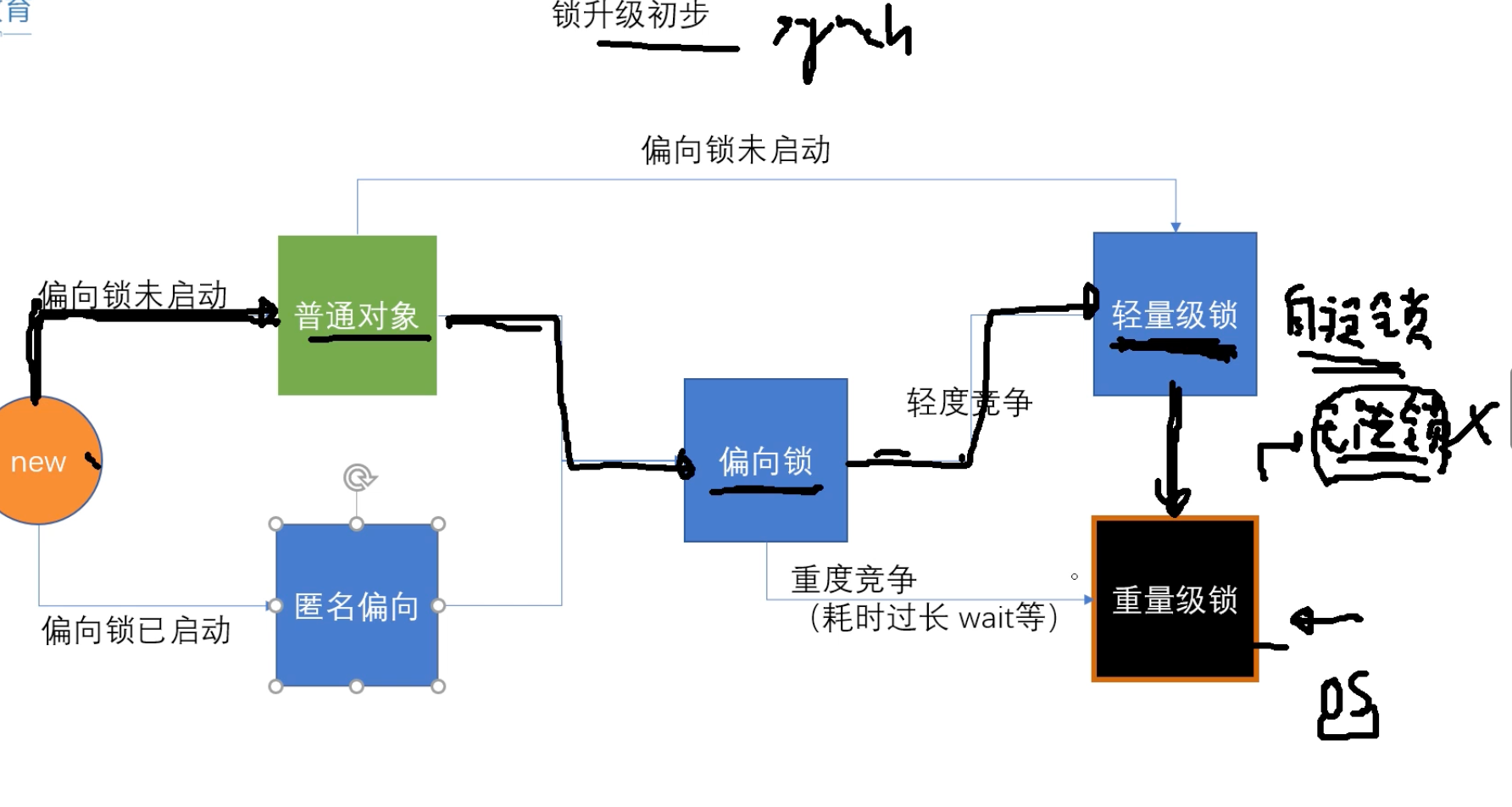
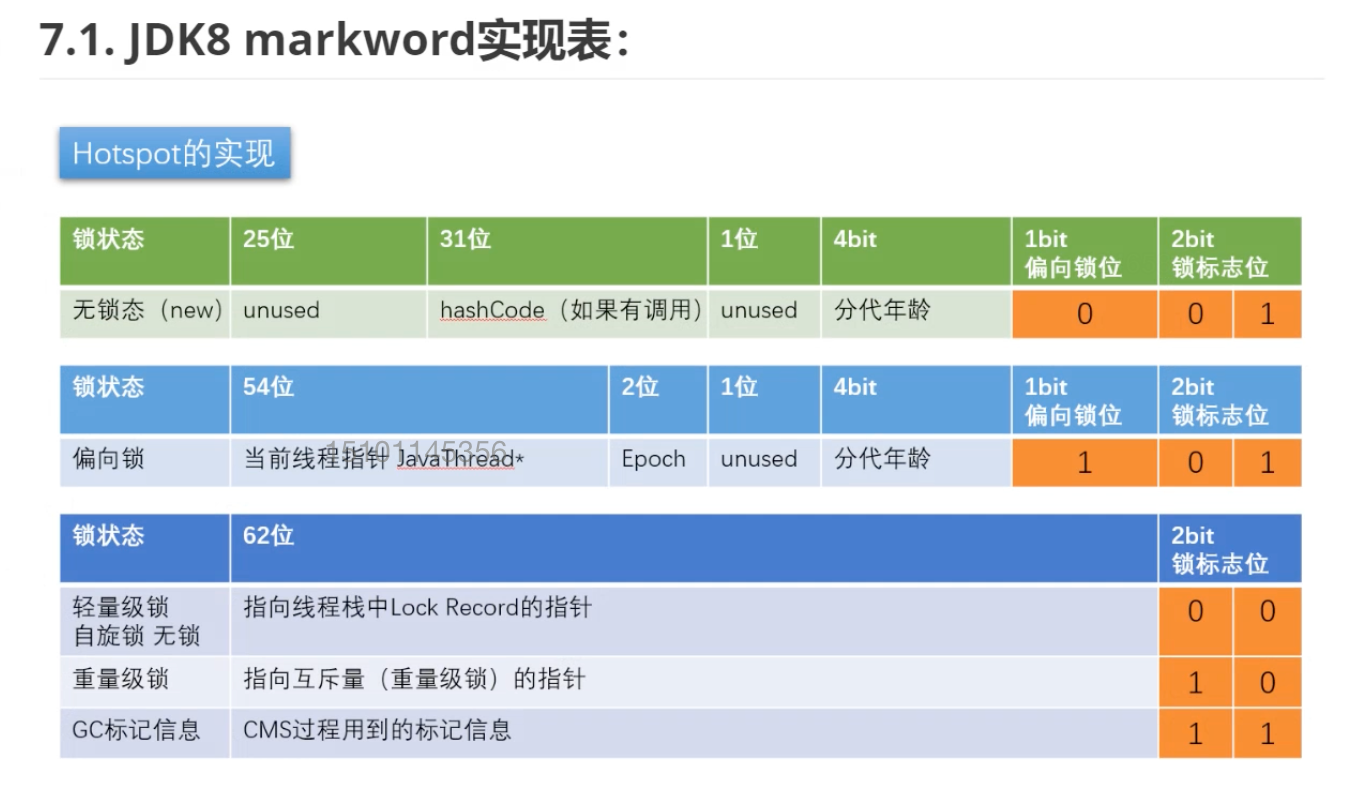

1.8 锁的升级过程
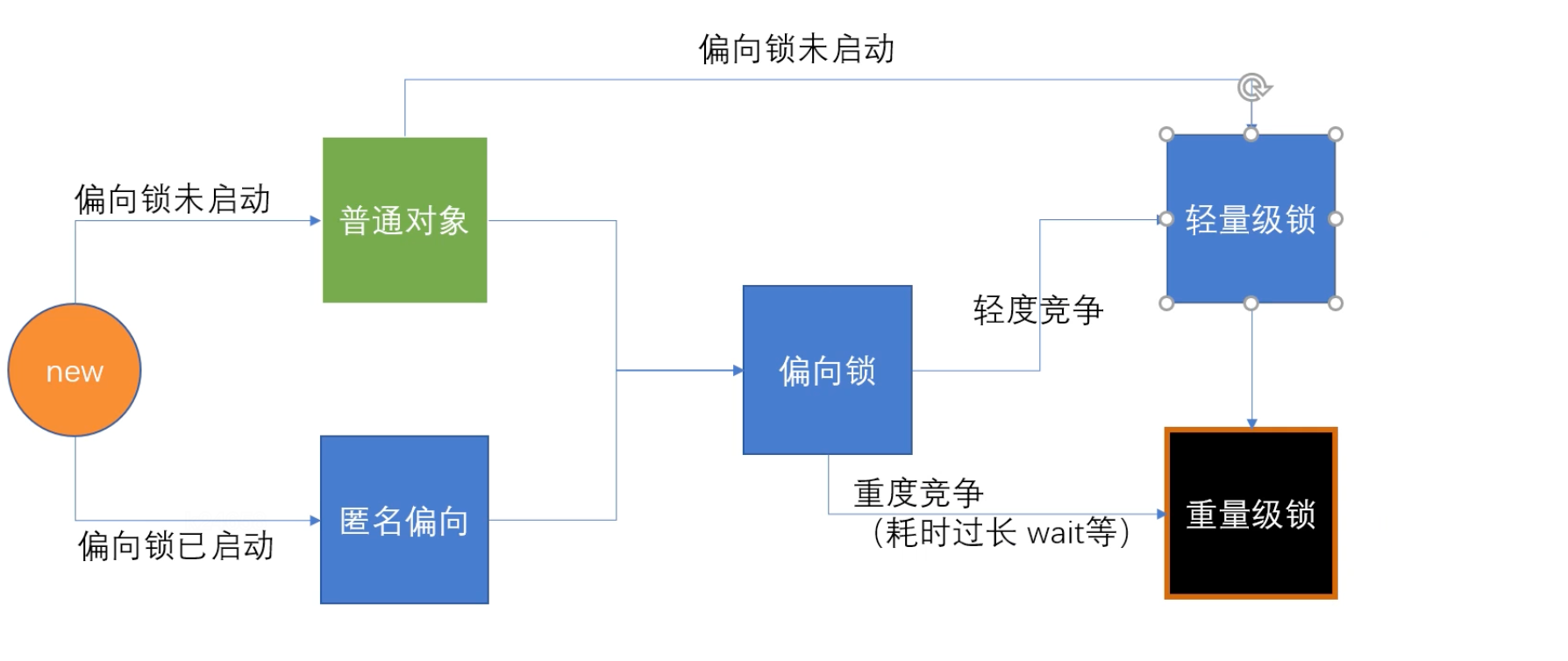
1.8.1 偏向锁
上偏向锁的时候没有竞争,这把锁你随便上;
1.8.2 自旋锁
作为稍微有竞争的两个线程时候,这个时候,撤销原来的偏向锁升级为自旋锁,他们在那里自选互相的竞争;各自有一个LR-LockRecord 锁记录)竞争成功了的线程就有个指针指向竞争成功的LR;宁一个线程就在那里自选等待;
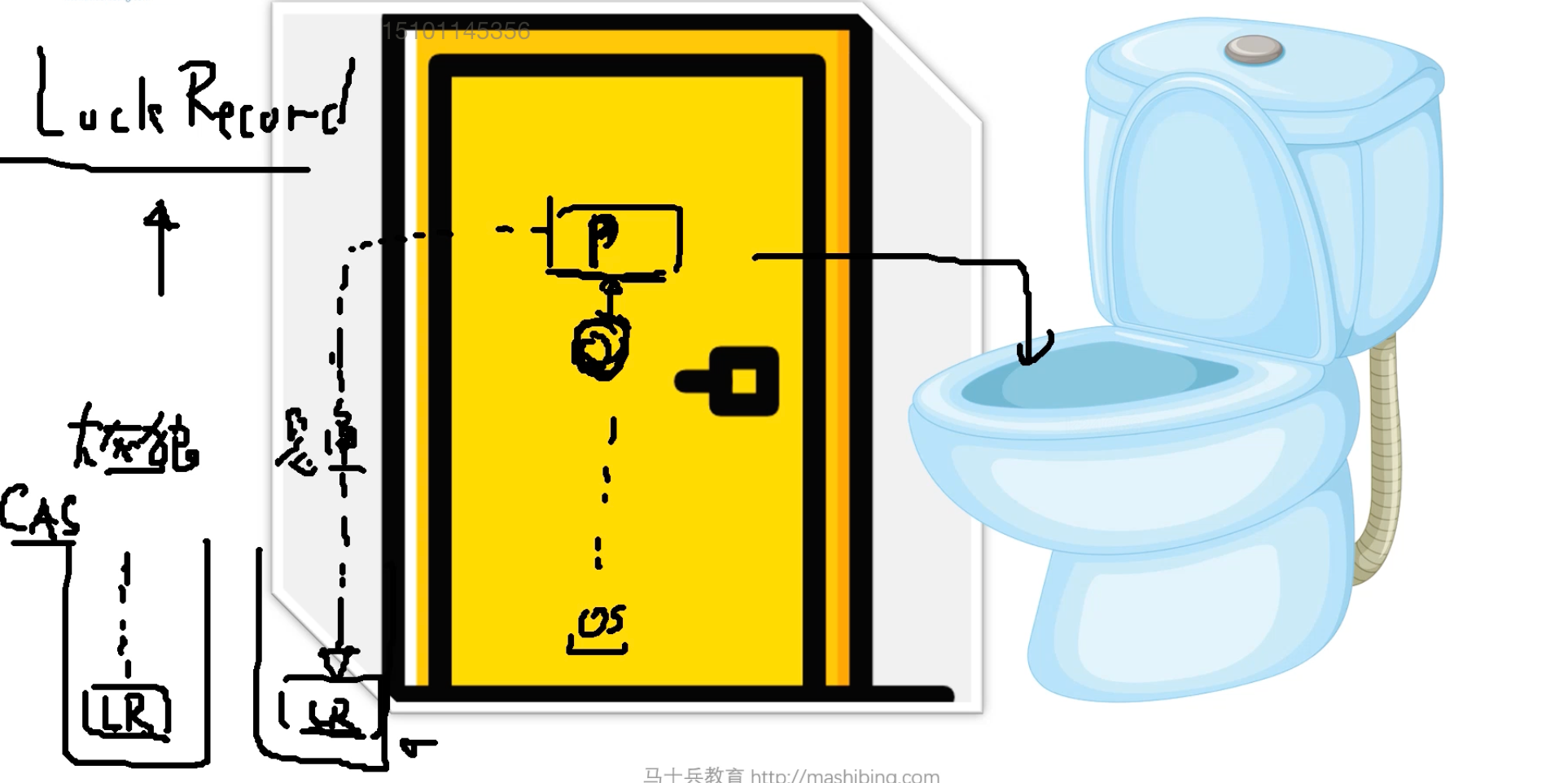
1.8.3重量级锁
说明当前不在是用户态,需要想操作系统申请了;当前记录的的objectMonitor
1.8.4 锁重入
当一个线程试图操作一个由其他线程持有的对象锁的临界资源时,将会处于阻塞状态,但当一个线程再次请求自己持有对象锁的临界资源时,如果当前锁是重入性,会请求将会成功,如果当前锁不是可重入性,会等待当前对象锁的释放,实际上该对象锁已被当前线程所持有,不可能再次获得,就会产生死锁,在java中synchronized是基于原子性的内部锁机制,是可重入的,因此在一个线程调用synchronized方法的同时在其方法体内部调用该对象另一个synchronized方法,也就是说一个线程得到一个对象锁后再次请求该对象锁,是允许的,还有就是当子类继承父类时,子类也是可以通过可重入锁调用父类的同步方法,这就是synchronized的可重入性。
不可重入的话就会死锁

1.8.5 轻量级锁什么时候升级为重量级锁?

1.8.6 偏向锁启动和偏向锁未启动?
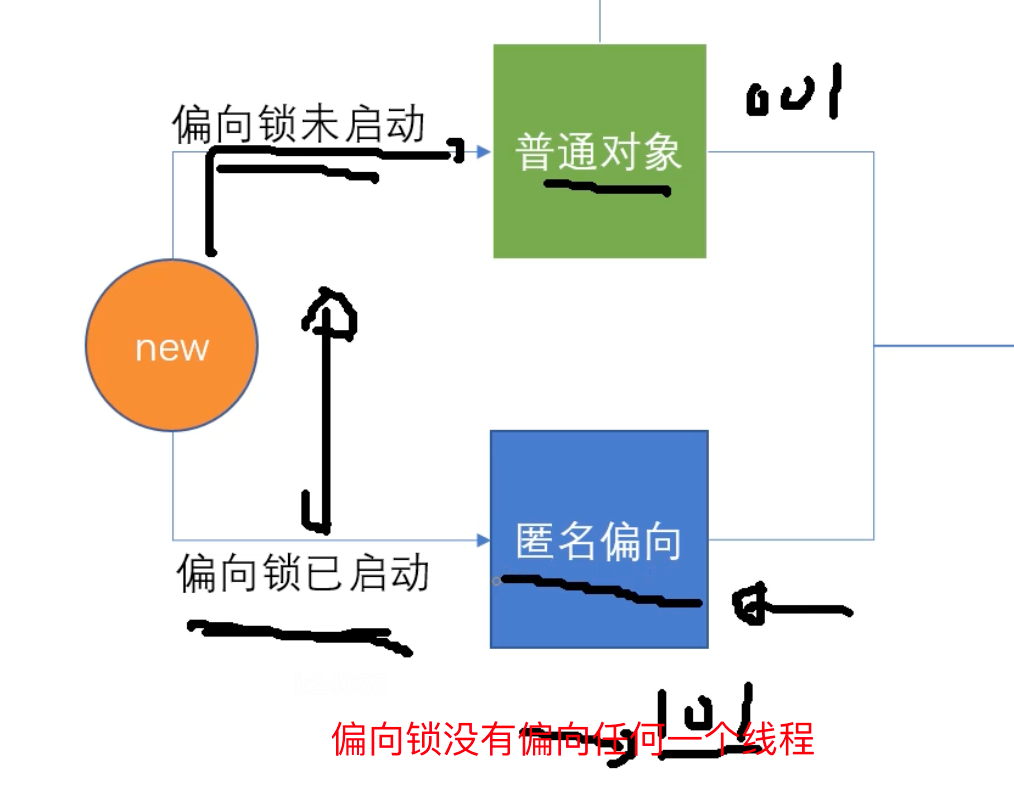
1.8.7偏向锁是否一定比自旋锁效率高?
不一定,在明确有多个线程竞争的情况下,偏向锁肯定会设计撤销,这时直接使用自旋锁,撤销也需要消耗cpu资源;
jvm默认启动时,会有很多线程竞争(明确)所以默认情况启动时不大开偏向锁,过一段时再打开;
1.8.9 为什么有自旋锁还要有重量级锁?
自选是消耗cpu资源的,如果锁的时间长,或者锁的数比较多,cpu会大量消耗;这种情况会被升级为重量级锁,
重量级锁有队列; 所有拿不到锁的进入等待队列,不消耗cpu资源;
2.0.0 什么时候用自旋锁,什么时候用重量级锁?
自旋锁- 执行时间短,线程数不是太多
重量级锁(系统锁)- 执行时间长,线程数多
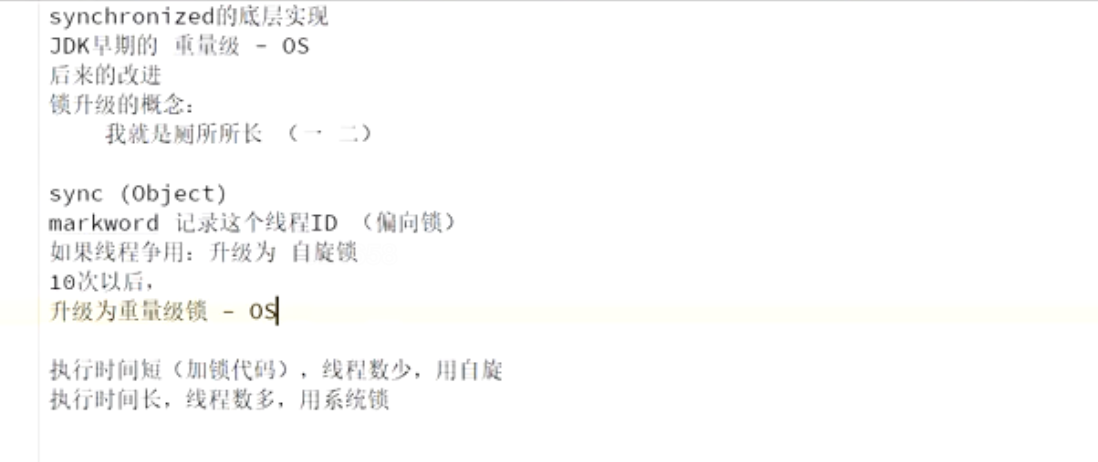
3 LongAdder
LongAdder在高并发时比AtomicLong更高效,LongAdder是根据ConcurrentHashMap这类为并发设计的类的基本原理——锁分段,来实现的,它里面维护一组按需分配的计数单元,并发计数时,不同的线程可以在不同的计数单元上进行计数,这样减少了线程竞争,提高了并发效率。本质上是用空间换时间的思想,不过在实际高并发情况中消耗的空间可以忽略不计。
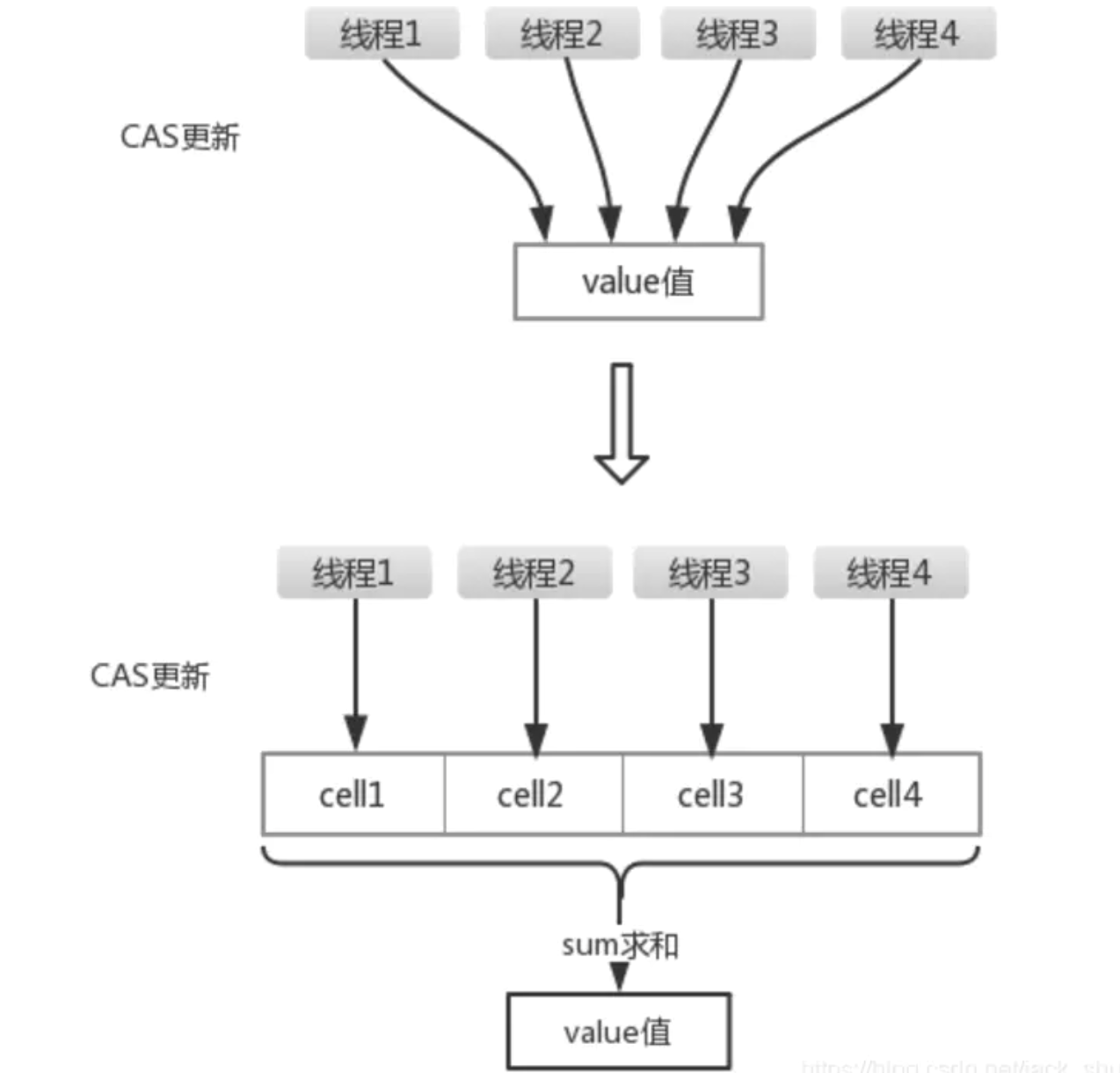
4 ReentrantLock
4.0 synchronized
/**
* reentrantlock用于替代synchronized
* 本例中由于m1锁定this,只有m1执行完毕的时候,m2才能执行
* 这里是复习synchronized最原始的语义
* @author mashibing
*/
package com.mashibing.juc.c_020;
import java.util.concurrent.TimeUnit;
public class T01_ReentrantLock1 {
synchronized void m1() {
for(int i=0; i<10; i++) {
try {
TimeUnit.SECONDS.sleep(1);
} catch (InterruptedException e) {
e.printStackTrace();
}
System.out.println(i);
if(i == 2) m2();
}
}
synchronized void m2() {
System.out.println("m2 ...");
}
public static void main(String[] args) {
T01_ReentrantLock1 rl = new T01_ReentrantLock1();
new Thread(rl::m1).start();
try {
TimeUnit.SECONDS.sleep(1);
} catch (InterruptedException e) {
e.printStackTrace();
}
//new Thread(rl::m2).start();
}
}
4.1 可代替synchronized(this)
ublic class T02_ReentrantLock2 {
Lock lock = new ReentrantLock();
void m1() {
try {
lock.lock(); //lock.lock代替synchronized(this)
for (int i = 0; i < 10; i++) {
TimeUnit.SECONDS.sleep(1);
System.out.println(i);
}
} catch (InterruptedException e) {
e.printStackTrace();
} finally {
lock.unlock(); //手动解锁,必须写在 finally
}
}
4.2 lock.lockInterruptibly(); //可以对interrupt()方法做出响应
public class T04_ReentrantLock4 {
public static void main(String[] args) {
Lock lock = new ReentrantLock();
Thread t1 = new Thread(()->{
try {
lock.lock();//不可打断
System.out.println("t1 start");
TimeUnit.SECONDS.sleep(Integer.MAX_VALUE);
System.out.println("t1 end");
} catch (InterruptedException e) {
System.out.println("interrupted!");
} finally {
lock.unlock();
}
});
t1.start();
Thread t2 = new Thread(()->{
try {
//lock.lock();
lock.lockInterruptibly(); //可以对interrupt()方法做出响应
System.out.println("t2 start");
TimeUnit.SECONDS.sleep(5);
System.out.println("t2 end");
} catch (InterruptedException e) {
System.out.println("interrupted!");
} finally {
lock.unlock();
}
});
t2.start();
try {
TimeUnit.SECONDS.sleep(1);
} catch (InterruptedException e) {
e.printStackTrace();
}
t2.interrupt(); //打断线程2的等待
}
}
4.3 ReentrantLock(true); //参数为true表示为公平锁
public class T05_ReentrantLock5 extends Thread {
private static ReentrantLock lock=new ReentrantLock(true); //参数为true表示为公平锁,请对比输出结果
public void run() {
for(int i=0; i<100; i++) {
lock.lock();
try{
System.out.println(Thread.currentThread().getName()+"获得锁");
}finally{
lock.unlock();
}
}
}
public static void main(String[] args) {
T05_ReentrantLock5 rl=new T05_ReentrantLock5();
Thread th1=new Thread(rl);
Thread th2=new Thread(rl);
th1.start();
th2.start();
}
}
4.4 ReentrantLock vs synchronized 区别
▪ cas vs sync
▪ trylock
▪ lockinterupptibly
▪ 公平和非公平
synchronized是非公平
5 CountDownLatch 门栓
CountDownLatch用于等待多少个线程全部结束再做什么
private static void usingCountDownLatch() {
Thread[] threads = new Thread[100];
CountDownLatch latch = new CountDownLatch(threads.length);
for(int i=0; i<threads.length; i++) {
threads[i] = new Thread(()->{
int result = 0;
for(int j=0; j<10000; j++) result += j;
latch.countDown();
});
}
for (int i = 0; i < threads.length; i++) {
threads[i].start();
}
try {
latch.await();//当不为0的时候就在这里等着
} catch (InterruptedException e) {
e.printStackTrace();
}
System.out.println("end latch");
}6 CyclicBarrier 循环栅栏 需要等到达到多少数了才往前执行,限流
public class T07_TestCyclicBarrier {
public static void main(String[] args) {
//CyclicBarrier barrier = new CyclicBarrier(20);
CyclicBarrier barrier = new CyclicBarrier(20, () -> System.out.println("满人"));
/*CyclicBarrier barrier = new CyclicBarrier(20, new Runnable() {
@Override
public void run() {
System.out.println("满人,发车");
}
});*/
for(int i=0; i<100; i++) {
new Thread(()->{
try {
barrier.await();//当人数为20的时候推到栅栏执行,小于20人的时候就在这里等着
} catch (InterruptedException e) {
e.printStackTrace();
} catch (BrokenBarrierException e) {
e.printStackTrace();
}
}).start();
}
}
}

7 Phaser 按照不同的阶段来对线程进行执行
需求 线程按照不同的阶段来执行需要用Phaser
public class T09_TestPhaser2 {
static Random r = new Random();
static MarriagePhaser phaser = new MarriagePhaser();
static void milliSleep(int milli) {
try {
TimeUnit.MILLISECONDS.sleep(milli);
} catch (InterruptedException e) {
e.printStackTrace();
}
}
public static void main(String[] args) {
phaser.bulkRegister(7);
for(int i=0; i<5; i++) {
new Thread(new Person("p" + i)).start();
}
new Thread(new Person("新郎")).start();
new Thread(new Person("新娘")).start();
}
static class MarriagePhaser extends Phaser {
@Override
protected boolean onAdvance(int phase, int registeredParties) {
switch (phase) {
case 0:
System.out.println("所有人到齐了!" + registeredParties);
System.out.println();
return false;
case 1:
System.out.println("所有人吃完了!" + registeredParties);
System.out.println();
return false;
case 2:
System.out.println("所有人离开了!" + registeredParties);
System.out.println();
return false;
case 3:
System.out.println("婚礼结束!新郎新娘抱抱!" + registeredParties);
return true;
default:
return true;
}
}
}
static class Person implements Runnable {
String name;
public Person(String name) {
this.name = name;
}
public void arrive() {
milliSleep(r.nextInt(1000));
System.out.printf("%s 到达现场!\n", name);
phaser.arriveAndAwaitAdvance();
}
public void eat() {
milliSleep(r.nextInt(1000));
System.out.printf("%s 吃完!\n", name);
phaser.arriveAndAwaitAdvance();
}
public void leave() {
milliSleep(r.nextInt(1000));
System.out.printf("%s 离开!\n", name);
phaser.arriveAndAwaitAdvance();
}
private void hug() {
if(name.equals("新郎") || name.equals("新娘")) {
milliSleep(r.nextInt(1000));
System.out.printf("%s 洞房!\n", name);
phaser.arriveAndAwaitAdvance();
} else {
phaser.arriveAndDeregister();
//phaser.register()
}
}
@Override
public void run() {
arrive();
eat();
leave();
hug();
}
}
}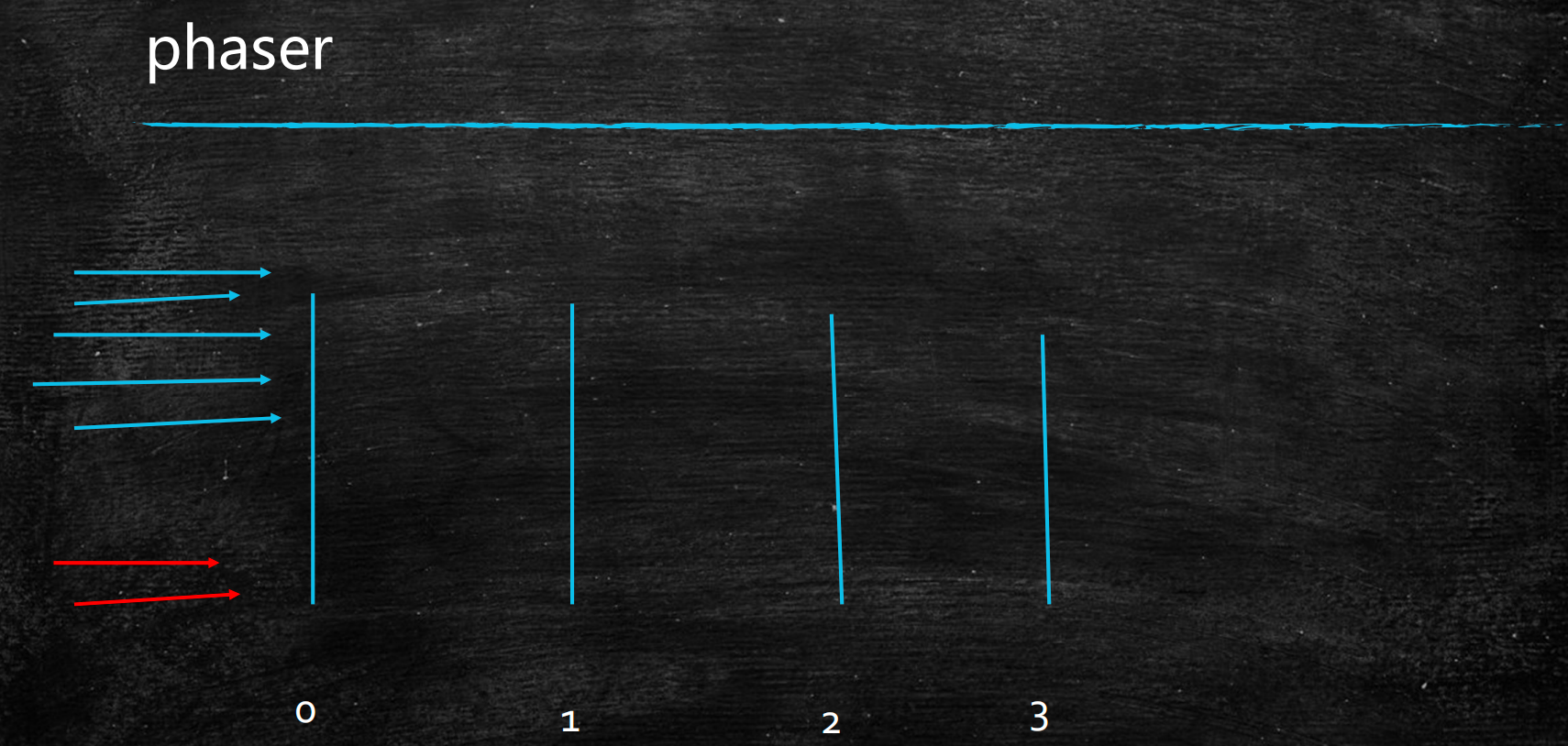
8 ReadWriteLock 读写锁 重要 (共享锁 排他锁)
import java.util.Random;
import java.util.concurrent.atomic.LongAdder;
import java.util.concurrent.locks.Lock;
import java.util.concurrent.locks.ReadWriteLock;
import java.util.concurrent.locks.ReentrantLock;
import java.util.concurrent.locks.ReentrantReadWriteLock;
public class T10_TestReadWriteLock {
static Lock lock = new ReentrantLock();
private static int value;
static ReadWriteLock readWriteLock = new ReentrantReadWriteLock();
static Lock readLock = readWriteLock.readLock();
static Lock writeLock = readWriteLock.writeLock();
public static void read(Lock lock) {
try {
lock.lock();
Thread.sleep(1000);
System.out.println("read over!");
//模拟读取操作
} catch (InterruptedException e) {
e.printStackTrace();
} finally {
lock.unlock();
}
}
public static void write(Lock lock, int v) {
try {
lock.lock();
Thread.sleep(1000);
value = v;
System.out.println("write over!");
//模拟写操作
} catch (InterruptedException e) {
e.printStackTrace();
} finally {
lock.unlock();
}
}8 Semaphore 信号量
import java.util.concurrent.Semaphore;
public class T11_TestSemaphore {
public static void main(String[] args) {
//Semaphore s = new Semaphore(2);//允许的数量 允许2个线程同时执行
Semaphore s = new Semaphore(2, true);
//允许一个线程同时执行
//Semaphore s = new Semaphore(1);
new Thread(()->{
try {
s.acquire();
System.out.println("T1 running...");
Thread.sleep(200);
System.out.println("T1 running...");
} catch (InterruptedException e) {
e.printStackTrace();
} finally {
s.release();
}
}).start();
new Thread(()->{
try {
s.acquire();
System.out.println("T2 running...");
Thread.sleep(200);
System.out.println("T2 running...");
s.release();
} catch (InterruptedException e) {
e.printStackTrace();
}
}).start();
}
}

9 Exchanger 只能是两个线程间交换
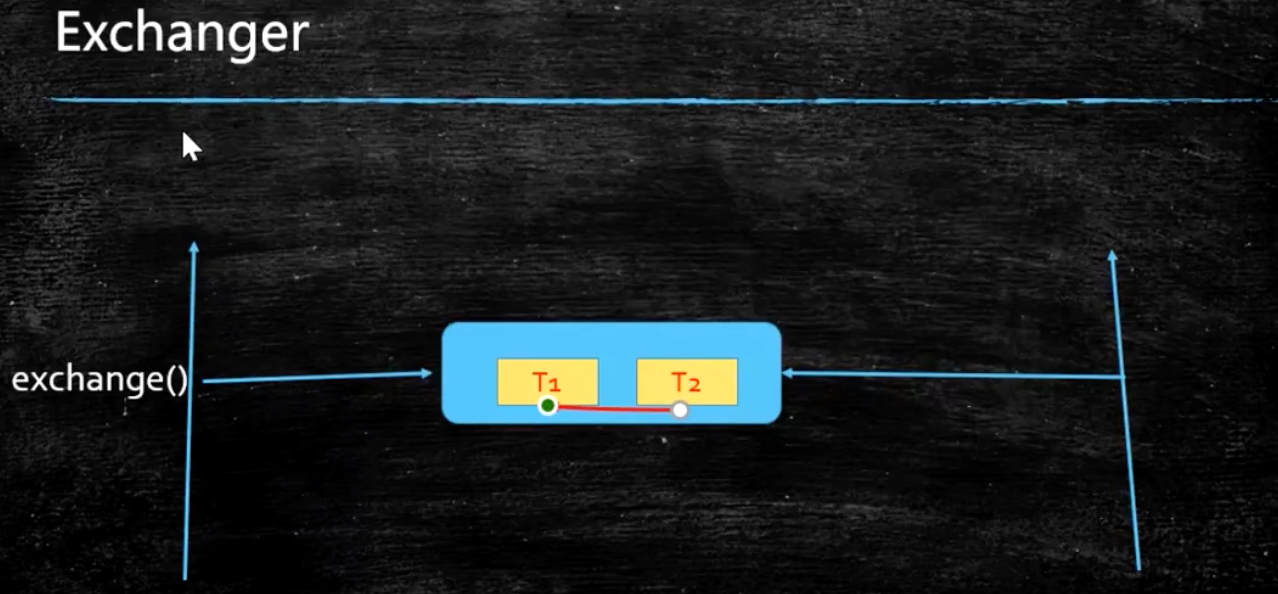
10 LockSupport
public class T13_TestLockSupport {
public static void main(String[] args) {
Thread t = new Thread(()->{
for (int i = 0; i < 10; i++) {
System.out.println(i);
if(i == 5) {
LockSupport.park();//i == 5的时候想停止的任何锁
}
try {
TimeUnit.SECONDS.sleep(1);
} catch (InterruptedException e) {
e.printStackTrace();
}
}
});
t.start();
LockSupport.unpark(t);
/*try {
TimeUnit.SECONDS.sleep(8);
} catch (InterruptedException e) {
e.printStackTrace();
}
System.out.println("after 8 senconds!");
LockSupport.unpark(t);*/
}
}
11 两个线程交叉打印数字 12345线程2 5673 Notify(不释放锁)和wait(释放锁)
实现一个容器,提供两个方法,add,size
写两个线程,线程1添加10个元素到容器中,线程2实现监控元素的个数,当
个数到5个时,线程2给出提示并结束
11.1 Notify(不释放锁)和wait 实现两个小程序来回切换打印的程序
import java.util.ArrayList;
import java.util.List;
import java.util.concurrent.TimeUnit;
public class T04_NotifyFreeLock {
//添加volatile,使t2能够得到通知
volatile List lists = new ArrayList();
public void add(Object o) {
lists.add(o);
}
public int size() {
return lists.size();
}
public static void main(String[] args) {
T04_NotifyFreeLock c = new T04_NotifyFreeLock();
final Object lock = new Object();
new Thread(() -> {
synchronized(lock) {
System.out.println("t2启动");
if(c.size() != 5) {
try {
lock.wait();
} catch (InterruptedException e) {
e.printStackTrace();
}
}
System.out.println("t2 结束");
//通知t1继续执行
lock.notify();
}
}, "t2").start();
try {
TimeUnit.SECONDS.sleep(1);
} catch (InterruptedException e1) {
e1.printStackTrace();
}
new Thread(() -> {
System.out.println("t1启动");
synchronized(lock) {
for(int i=0; i<10; i++) {
c.add(new Object());
System.out.println("add " + i);
if(c.size() == 5) {
lock.notify();//notify 不释放锁,需要lock.wait();让出一把锁,线程2才可以拿到
//释放锁,让t2得以执行
try {
lock.wait();
} catch (InterruptedException e) {
e.printStackTrace();
}
}
try {
TimeUnit.SECONDS.sleep(1);
} catch (InterruptedException e) {
e.printStackTrace();
}
}
}
}, "t1").start();
}
}

11.2以上两个线程小程序可以通过CountDownLatch 两个门栓来实现
public class T05_CountDownLatch {
// 添加volatile,使t2能够得到通知
volatile List lists = new ArrayList();
public void add(Object o) {
lists.add(o);
}
public int size() {
return lists.size();
}
public static void main(String[] args) {
T05_CountDownLatch c = new T05_CountDownLatch();
CountDownLatch latch = new CountDownLatch(1);
new Thread(() -> {
System.out.println("t2启动");
if (c.size() != 5) {
try {
latch.await();
//也可以指定等待时间
//latch.await(5000, TimeUnit.MILLISECONDS);
} catch (InterruptedException e) {
e.printStackTrace();
}
}
System.out.println("t2 结束");
}, "t2").start();
try {
TimeUnit.SECONDS.sleep(1);
} catch (InterruptedException e1) {
e1.printStackTrace();
}
new Thread(() -> {
System.out.println("t1启动");
for (int i = 0; i < 10; i++) {
c.add(new Object());
System.out.println("add " + i);
if (c.size() == 5) {
// 打开门闩,让t2得以执行
latch.countDown();
}
//把这里注释掉就不行,用两个门栓来解决
/*try {
TimeUnit.SECONDS.sleep(1);
} catch (InterruptedException e) {
e.printStackTrace();
}*/
}
}, "t1").start();
}
}
11.3 两个 LockSupport来实现
public class T07_LockSupport_WithoutSleep {
// 添加volatile,使t2能够得到通知
volatile List lists = new ArrayList();
public void add(Object o) {
lists.add(o);
}
public int size() {
return lists.size();
}
static Thread t1 = null, t2 = null;
public static void main(String[] args) {
T07_LockSupport_WithoutSleep c = new T07_LockSupport_WithoutSleep();
t1 = new Thread(() -> {
System.out.println("t1启动");
for (int i = 0; i < 10; i++) {
c.add(new Object());
System.out.println("add " + i);
if (c.size() == 5) {
LockSupport.unpark(t2);
LockSupport.park();
}
}
}, "t1");
t2 = new Thread(() -> {
//System.out.println("t2启动");
//if (c.size() != 5) {
LockSupport.park();
//}
System.out.println("t2 结束");
LockSupport.unpark(t1);
}, "t2");
t2.start();
t1.start();
}
}
11.4 Semaphore 加 join来实现
import java.util.ArrayList;
import java.util.List;
import java.util.concurrent.Semaphore;
import java.util.concurrent.locks.LockSupport;
public class T08_Semaphore {
// 添加volatile,使t2能够得到通知
volatile List lists = new ArrayList();
public void add(Object o) {
lists.add(o);
}
public int size() {
return lists.size();
}
static Thread t1 = null, t2 = null;
public static void main(String[] args) {
T08_Semaphore c = new T08_Semaphore();
Semaphore s = new Semaphore(1);
t1 = new Thread(() -> {
try {
s.acquire();
for (int i = 0; i < 5; i++) {
c.add(new Object());
System.out.println("add " + i);
}
s.release();
} catch (InterruptedException e) {
e.printStackTrace();
}
try {
t2.start();
t2.join();
} catch (InterruptedException e) {
e.printStackTrace();
}
try {
s.acquire();
for (int i = 5; i < 10; i++) {
System.out.println(i);
}
s.release();
} catch (InterruptedException e) {
e.printStackTrace();
}
}, "t1");
t2 = new Thread(() -> {
try {
s.acquire();
System.out.println("t2 结束");
s.release();
} catch (InterruptedException e) {
e.printStackTrace();
}
}, "t2");
//t2.start();
t1.start();
}
}
12 两个线程交互打印 1a2b3c4d5e6f?
13 生产者消费者
13.1synchronized(同步容器-背)
写一个固定容量同步容器,拥有put和get方法,以及getCount方法,
能够支持2个生产者线程以及10个消费者线程的阻塞调用
使用 wait和notifyAll来实现
/**
* 面试题:写一个固定容量同步容器,拥有put和get方法,以及getCount方法,
* 能够支持2个生产者线程以及10个消费者线程的阻塞调用
*
* 使用wait和notify/notifyAll来实现
*
* @author mashibing
*/
package com.mashibing.juc.c_021_01_interview;
import java.util.LinkedList;
import java.util.concurrent.TimeUnit;
//同步容器
public class MyContainer1<T> {
final private LinkedList<T> lists = new LinkedList<>();
final private int MAX = 10; //最多10个元素
private int count = 0;
public synchronized void put(T t) {
while(lists.size() == MAX) { //想想为什么用while而不是用if?
try {
this.wait(); //effective java
} catch (InterruptedException e) {
e.printStackTrace();
}
}
lists.add(t);
++count;
this.notifyAll(); //通知消费者线程进行消费
}
public synchronized T get() {
T t = null;
while(lists.size() == 0) {
try {
this.wait();
} catch (InterruptedException e) {
e.printStackTrace();
}
}
t = lists.removeFirst();
count --;
this.notifyAll(); //通知生产者进行生产
return t;
}
public static void main(String[] args) {
MyContainer1<String> c = new MyContainer1<>();
//启动消费者线程
for(int i=0; i<10; i++) {
new Thread(()->{
for(int j=0; j<5; j++) System.out.println(c.get());
}, "c" + i).start();
}
try {
TimeUnit.SECONDS.sleep(2);
} catch (InterruptedException e) {
e.printStackTrace();
}
//启动生产者线程
for(int i=0; i<2; i++) {
new Thread(()->{
for(int j=0; j<25; j++) c.put(Thread.currentThread().getName() + " " + j);
}, "p" + i).start();
}
}
}
13.1 ReentrantLock 不同的等待队列
/**
* 面试题:写一个固定容量同步容器,拥有put和get方法,以及getCount方法,
* 能够支持2个生产者线程以及10个消费者线程的阻塞调用
*
* 使用wait和notify/notifyAll来实现
*
* 使用Lock和Condition来实现
* 对比两种方式,Condition的方式可以更加精确的指定哪些线程被唤醒
*
* @author mashibing
*/
package com.mashibing.juc.c_021_01_interview;
import java.util.LinkedList;
import java.util.concurrent.TimeUnit;
import java.util.concurrent.locks.Condition;
import java.util.concurrent.locks.Lock;
import java.util.concurrent.locks.ReentrantLock;
public class MyContainer2<T> {
final private LinkedList<T> lists = new LinkedList<>();
final private int MAX = 10; //最多10个元素
private int count = 0;
private Lock lock = new ReentrantLock();//能够精确的叫醒那些线程
private Condition producer = lock.newCondition();
private Condition consumer = lock.newCondition();
public void put(T t) {
try {
lock.lock();
while(lists.size() == MAX) { //想想为什么用while而不是用if?
producer.await();
}
lists.add(t);
++count;
consumer.signalAll(); //通知消费者线程进行消费,只叫醒consumer
} catch (InterruptedException e) {
e.printStackTrace();
} finally {
lock.unlock();
}
}
public T get() {
T t = null;
try {
lock.lock();
while(lists.size() == 0) {
consumer.await();
}
t = lists.removeFirst();
count --;
producer.signalAll(); //通知生产者进行生产
} catch (InterruptedException e) {
e.printStackTrace();
} finally {
lock.unlock();
}
return t;
}
public static void main(String[] args) {
MyContainer2<String> c = new MyContainer2<>();
//启动消费者线程
for(int i=0; i<10; i++) {
new Thread(()->{
for(int j=0; j<5; j++) System.out.println(c.get());
}, "c" + i).start();
}
try {
TimeUnit.SECONDS.sleep(2);
} catch (InterruptedException e) {
e.printStackTrace();
}
//启动生产者线程
for(int i=0; i<2; i++) {
new Thread(()->{
for(int j=0; j<25; j++) c.put(Thread.currentThread().getName() + " " + j);
}, "p" + i).start();
}
}
}
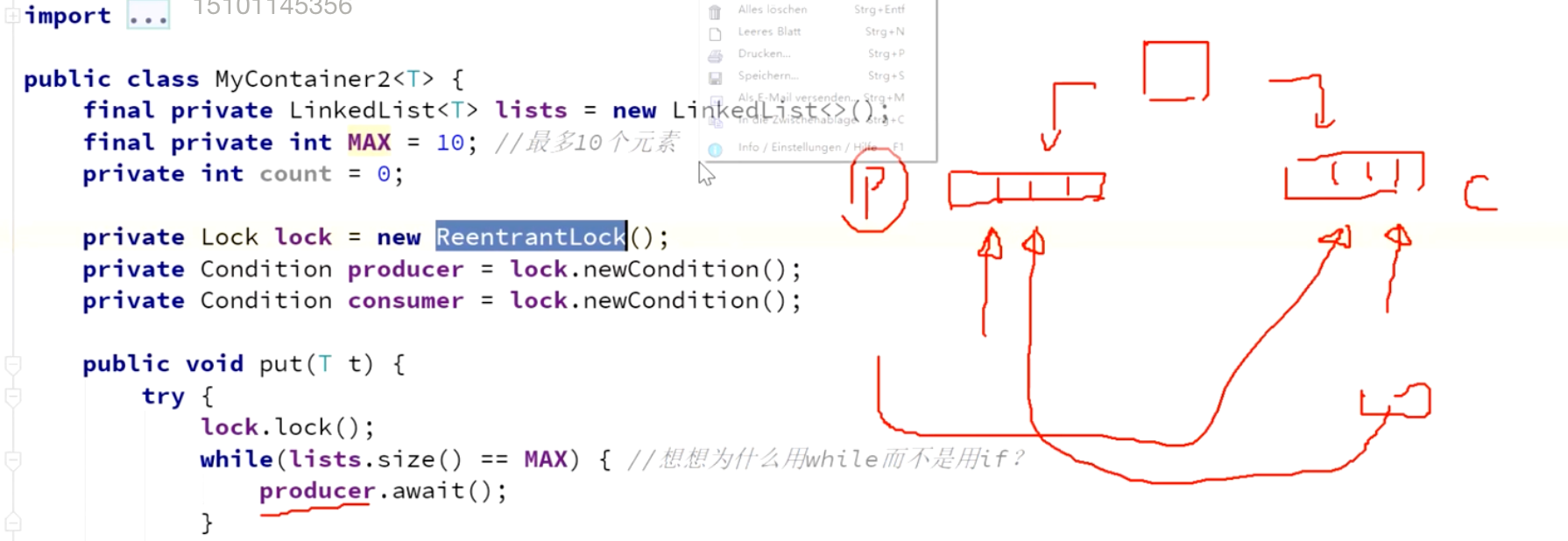
14 AQS源码解读- AbstractQueuedSynchronizer
谈一下AQS
为什么说AQS底层是 CAS +volatile?
state 是volatile修饰的,并且设置state的方法除了有setState ,还有compareAndSetState
1 方法调用图
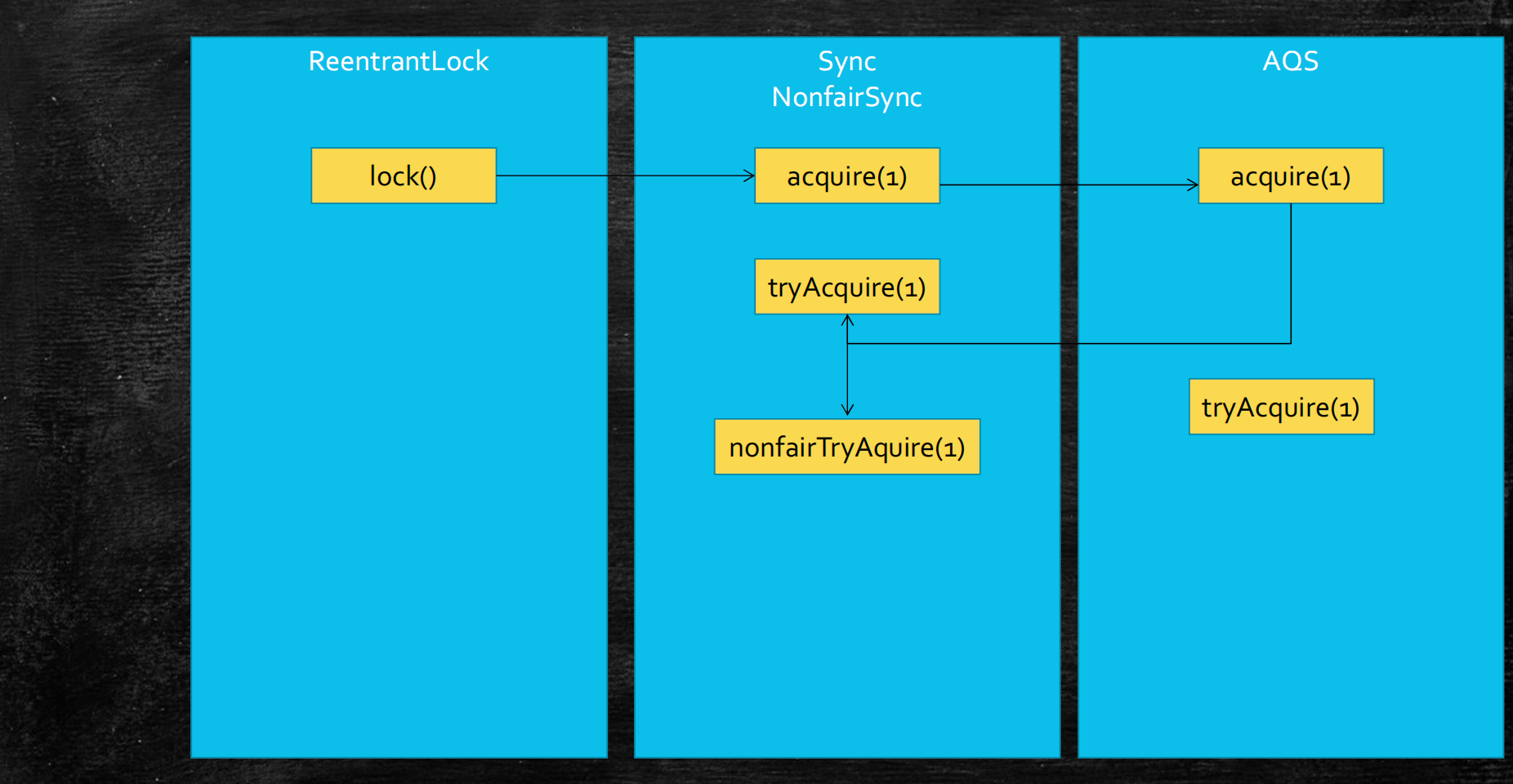
2 类之间的继承图

3 结构图
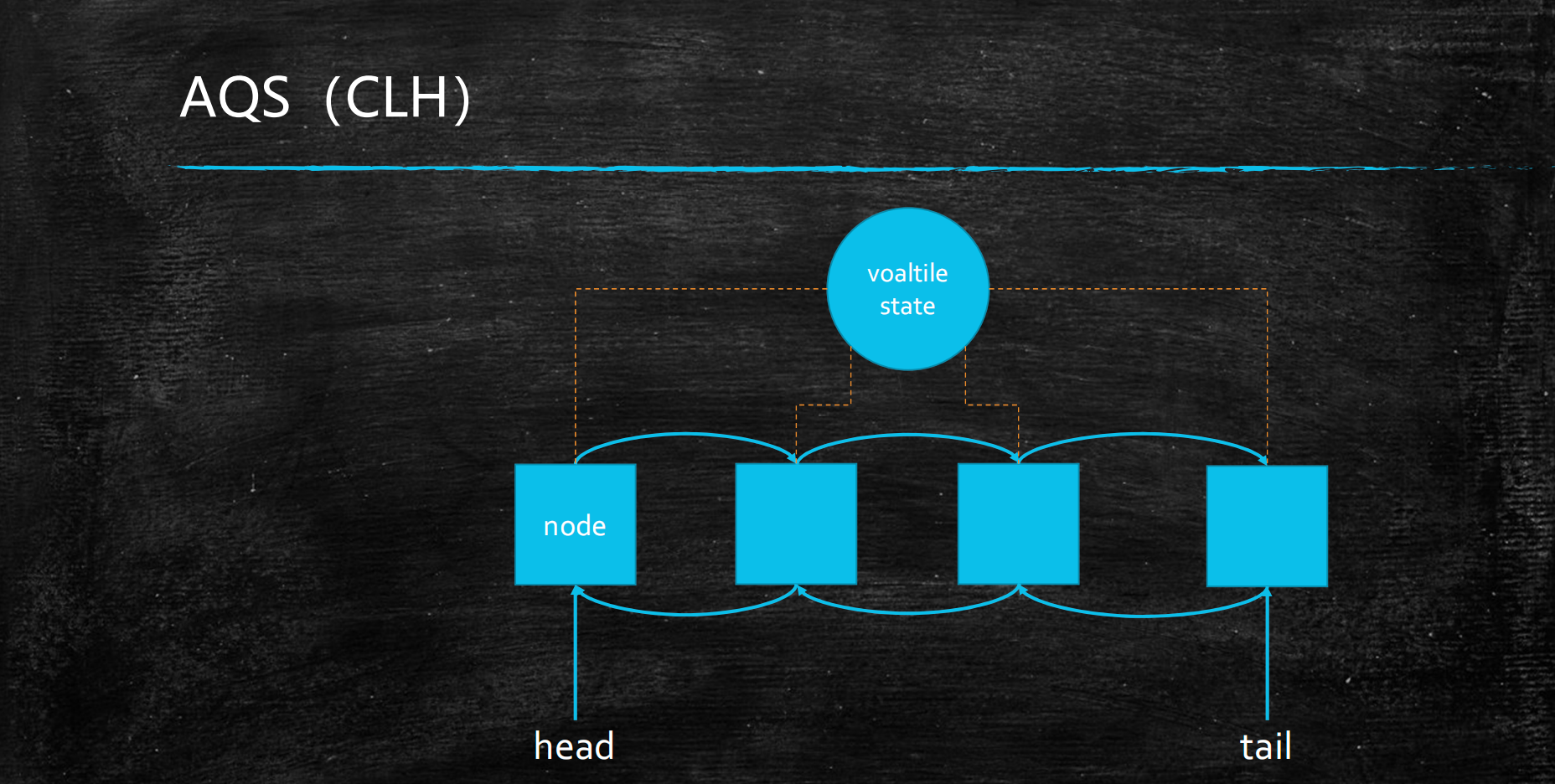
15 ThreadLocal
set
– Thread.currentThread. map(ThreadLocal, person)
– 设到了当前线程的map中
ThreadLocal源码
public void set(T value) {
Thread t = Thread.currentThread();
ThreadLocalMap map = getMap(t);
if (map != null) {
map.set(this, value);
} else {
createMap(t, value);
}
}
public T get() {
Thread t = Thread.currentThread();
ThreadLocalMap map = getMap(t);
if (map != null) {
ThreadLocalMap.Entry e = map.getEntry(this);
if (e != null) {
@SuppressWarnings("unchecked")
T result = (T)e.value;
return result;
}
}
return setInitialValue();
}15.1 java的引用分为 强 软 弱 虚
强引用 普通的引用就是强引用
用途
public class T01_NormalReference {
public static void main(String[] args) throws IOException {
M m = new M();
m = null;
System.gc(); //DisableExplicitGC
System.in.read();
}
}软引用 当一个对象被软引用所指向的时候,只有系统内存不够用的时候才会回收他
用途:做缓存来用
package com.mashibing.juc.c_022_RefTypeAndThreadLocal;
import java.lang.ref.SoftReference;
public class T02_SoftReference {
public static void main(String[] args) {
SoftReference<byte[]> m = new SoftReference<>(new byte[1024*1024*10]);
//m = null;
System.out.println(m.get());
System.gc();
try {
Thread.sleep(500);
} catch (InterruptedException e) {
e.printStackTrace();
}
System.out.println(m.get());
//再分配一个数组,heap将装不下,这时候系统会垃圾回收,先回收一次,如果不够,会把软引用干掉
byte[] b = new byte[1024*1024*15];
System.out.println(m.get());
}
}
//软引用非常适合缓存使用
弱引用 弱引用遭到gc就会回收 当有宁外一个强引用指向他的时候,当强引用消失的时候,他就应该自动被回收掉
用途:一般用于容器 列入ThreadLocal
/**
* 弱引用遭到gc就会回收
*
*/
package com.mashibing.juc.c_022_RefTypeAndThreadLocal;
import java.lang.ref.WeakReference;
public class T03_WeakReference {
public static void main(String[] args) {
WeakReference<M> m = new WeakReference<>(new M());
System.out.println(m.get());
System.gc();
System.out.println(m.get());
ThreadLocal<M> tl = new ThreadLocal<>();
tl.set(new M());
tl.remove();
}
}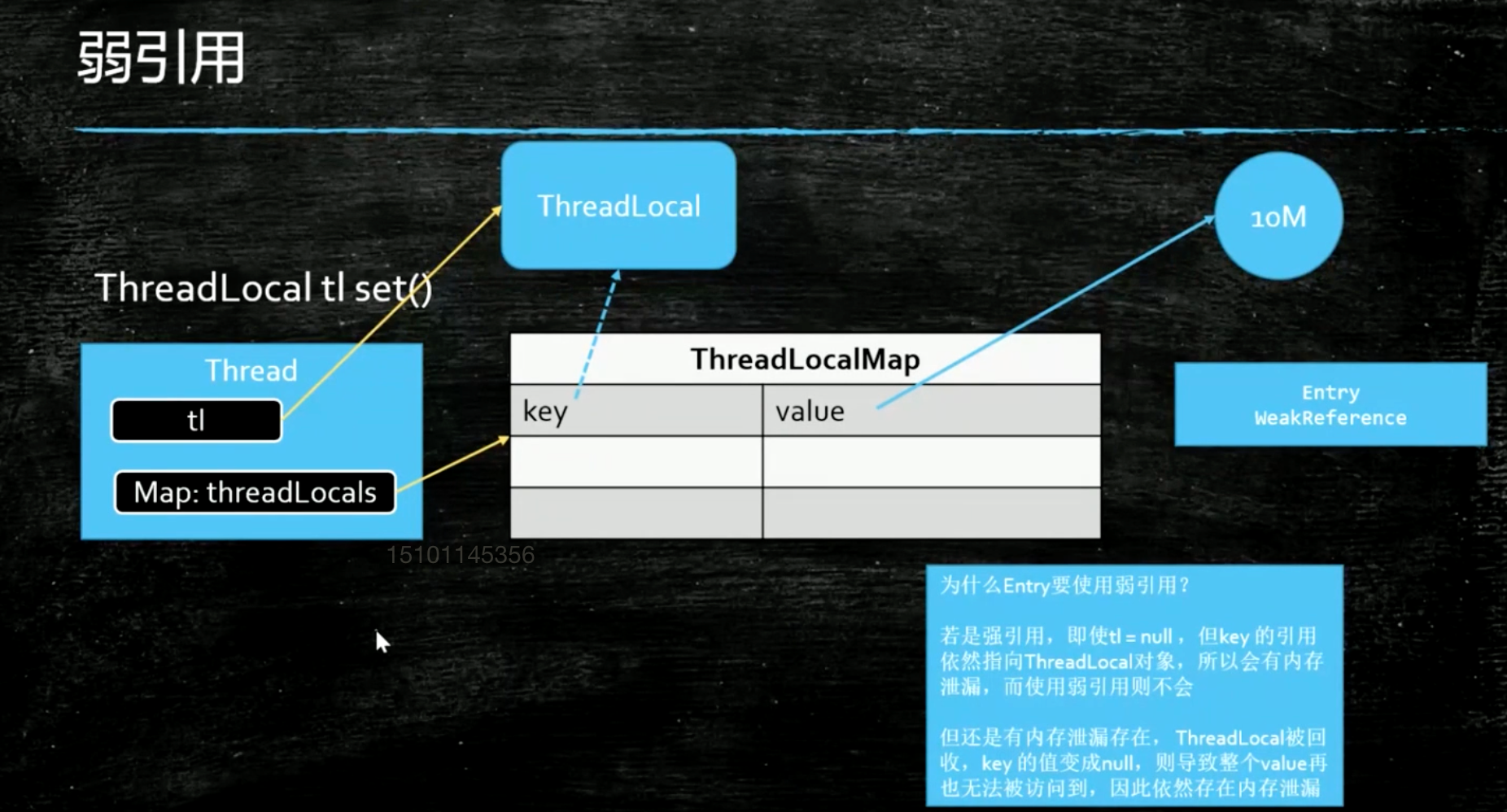
虚引用 对堆外内存进行回收
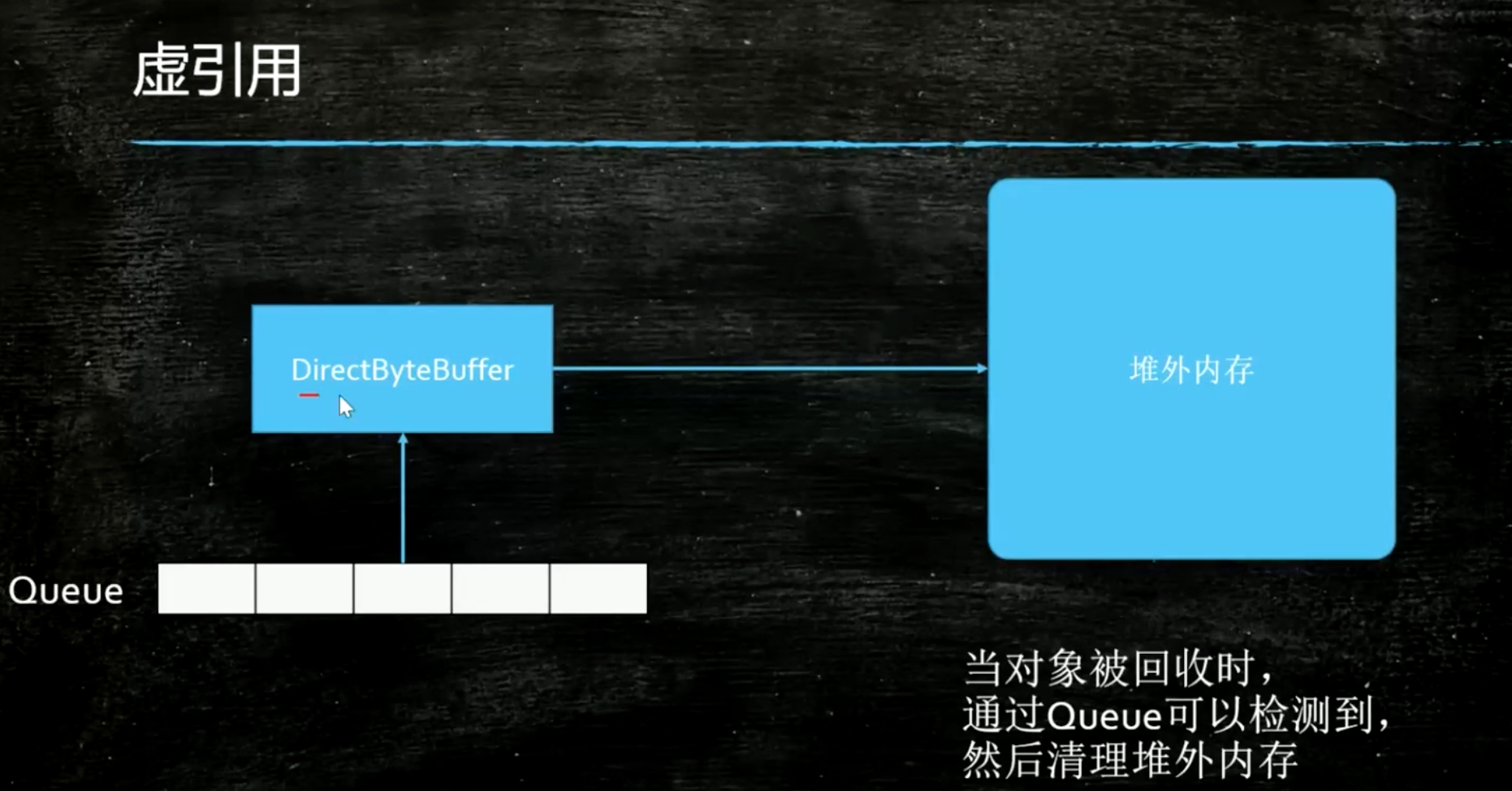























 692
692











 被折叠的 条评论
为什么被折叠?
被折叠的 条评论
为什么被折叠?








